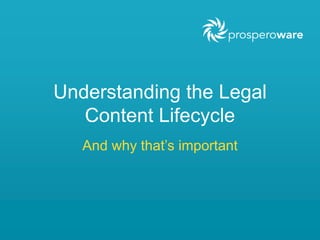Understanding the legal content lifecycle
- 1. Understanding the Legal Content Lifecycle And why thatŌĆÖs important
- 2. If you understand the basic lifecycle of legal content . . . and the unintended consequences that often arise during that cycle . . .
- 3. , , , youŌĆÖll find that your lawyers are more productive and your firm is less exposed to risk.
- 4. Legal content lifecycle Three parts that form a continuum of closely related content LEGAL CONTENT LIFECYCLE
- 5. Work in progress The practice of law is primarily about the creation of documents
- 6. Unintended consequence The failure to have clear procedures on version control can lead to: ŌĆó Editing the wrong document ŌĆó Producing a final document that has not been fully vetted ŌĆó Exposing the firm to potential malpractice.
- 7. Knowledge Much of the firmŌĆÖs knowledge is captured in ŌĆó Prior work product ŌĆó Practice area templates as well as ŌĆó Practice notes ŌĆó Notes on case law ŌĆó Client advisory ŌĆó Checklists http://
- 8. Unintended consequence Full-text search isnŌĆÖt very useful ŌĆó Templates and prior work product often use the same words No incentive to profile documents ŌĆó Typical DMS profile is ŌĆ£documentŌĆØ or ŌĆ£miscellaneousŌĆØŌĆö neither facilitates searches
- 9. Records All the final documents the firm generates grouped according to type: ŌĆó Client documents ŌĆó Received letters, email ŌĆó Pleadings filed by the other side ŌĆó Documents filed by the other side ŌĆó Agreements and drafts ŌĆó Court orders ŌĆó Other govŌĆÖt documents ŌĆó Research
- 10. Unintended consequence Clients own most of the file. Without good records management: ŌĆó Firm cannot implement retention policies internally ŌĆó Firm will be unable to satisfy client requirements for retention on their content ŌĆó Failure to comply with either can result in malpractice or sanctions for spoliation of data
- 11. How well do you understand the legal content lifecycle? Is your firm experiencing any of these unintended consequences? LEGAL CONTENT LIFECYCLE
- 12. LEARN MORE ŌĆó Printable brief: Understanding the Legal Content Lifecycle ŌĆó ║▌║▌▀Żshare: Matter Centricity 101 ŌĆó ║▌║▌▀Żshare: Rethinking Matter Centricity












